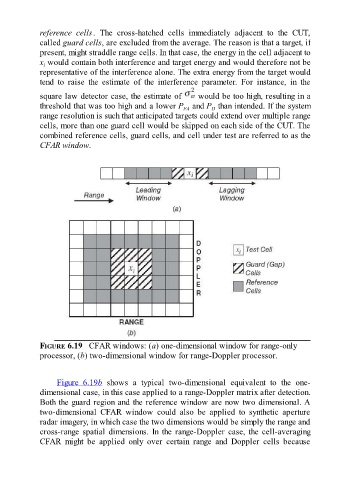Page 502 - Fundamentals of Radar Signal Processing
P. 502
reference cells. The cross-hatched cells immediately adjacent to the CUT,
called guard cells, are excluded from the average. The reason is that a target, if
present, might straddle range cells. In that case, the energy in the cell adjacent to
x would contain both interference and target energy and would therefore not be
i
representative of the interference alone. The extra energy from the target would
tend to raise the estimate of the interference parameter. For instance, in the
square law detector case, the estimate of would be too high, resulting in a
threshold that was too high and a lower P and P than intended. If the system
D
FA
range resolution is such that anticipated targets could extend over multiple range
cells, more than one guard cell would be skipped on each side of the CUT. The
combined reference cells, guard cells, and cell under test are referred to as the
CFAR window.
FIGURE 6.19 CFAR windows: (a) one-dimensional window for range-only
processor, (b) two-dimensional window for range-Doppler processor.
Figure 6.19b shows a typical two-dimensional equivalent to the one-
dimensional case, in this case applied to a range-Doppler matrix after detection.
Both the guard region and the reference window are now two dimensional. A
two-dimensional CFAR window could also be applied to synthetic aperture
radar imagery, in which case the two dimensions would be simply the range and
cross-range spatial dimensions. In the range-Doppler case, the cell-averaging
CFAR might be applied only over certain range and Doppler cells because

